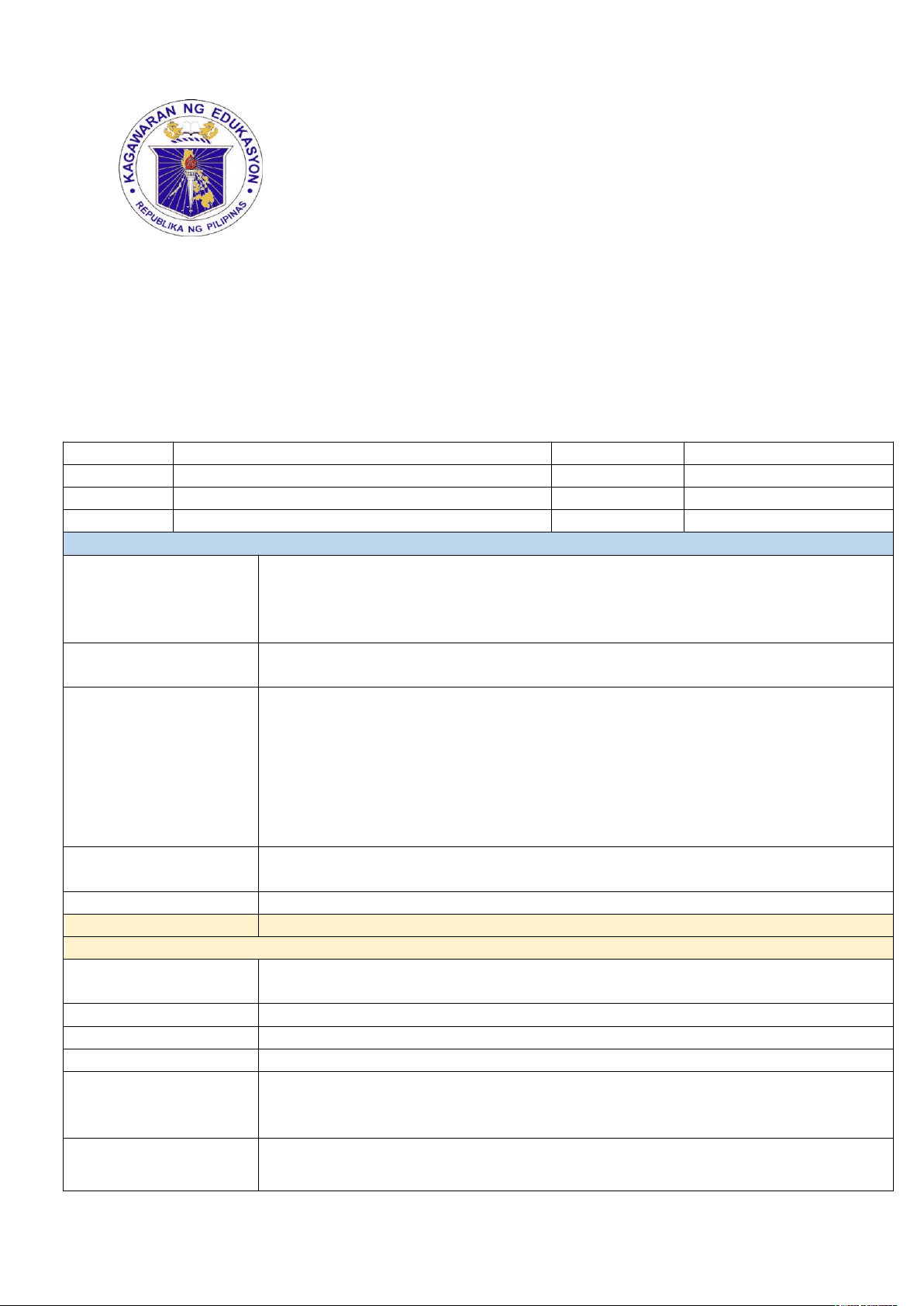
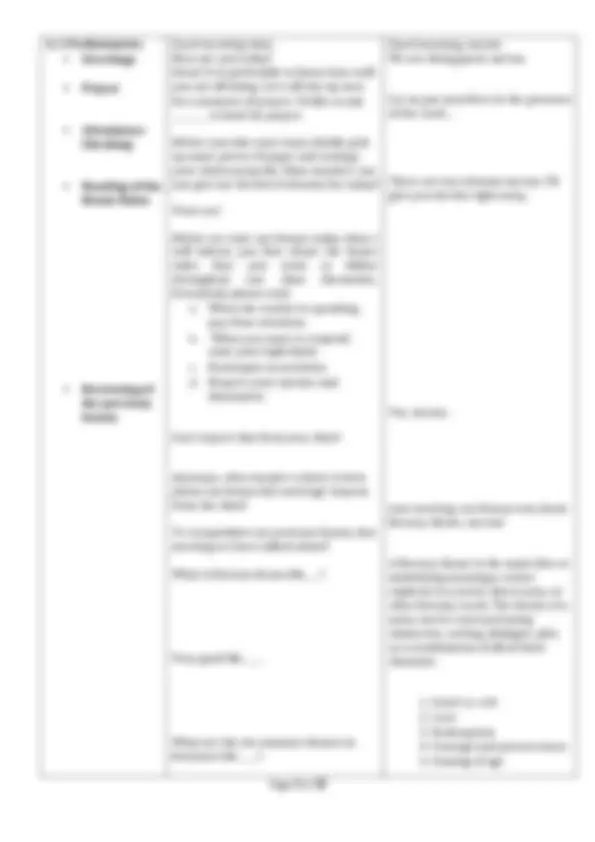
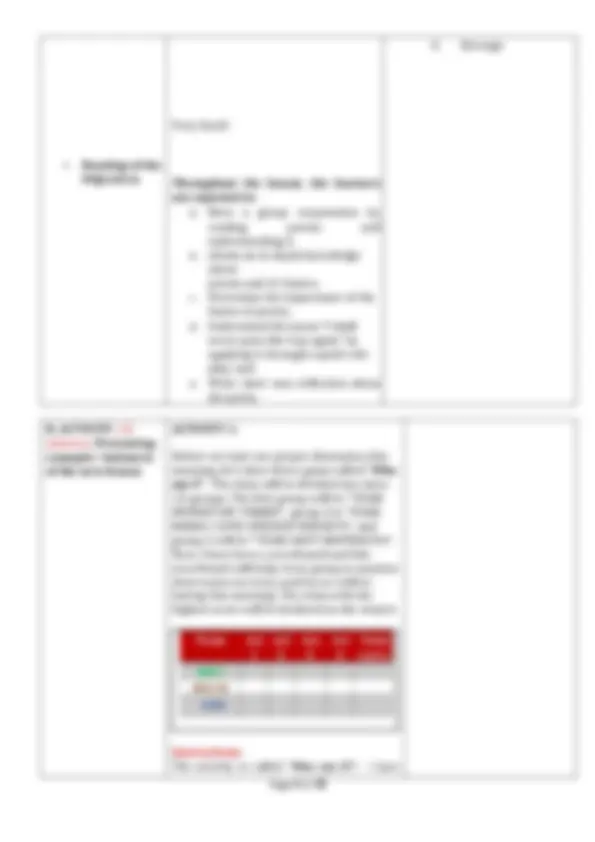
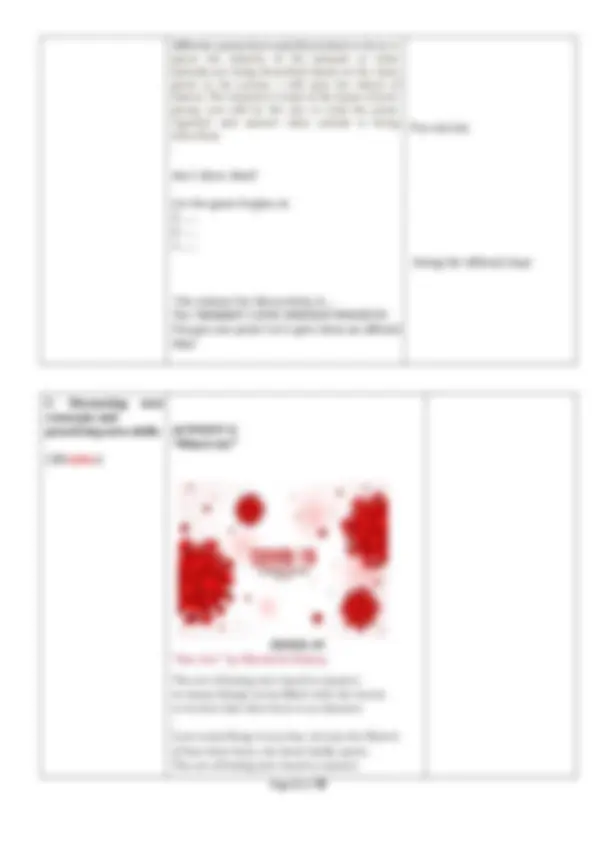
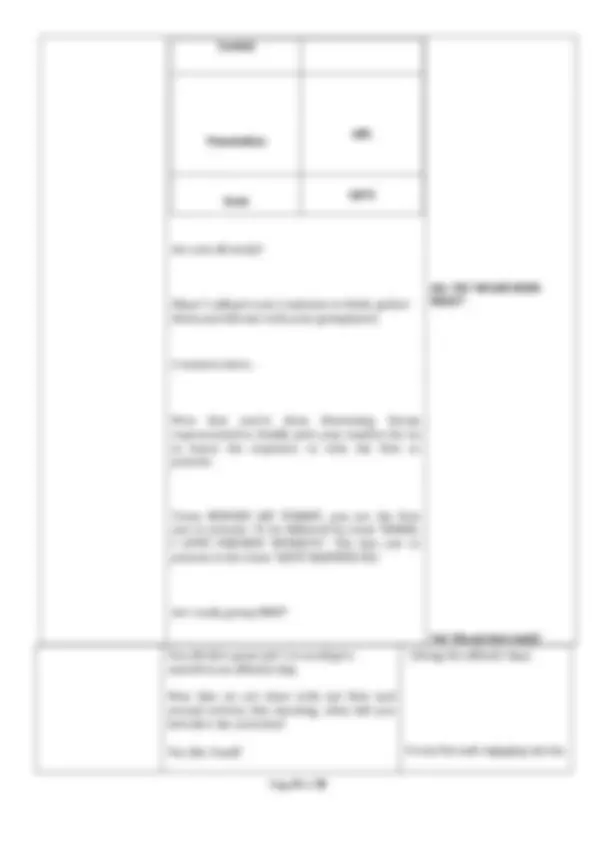
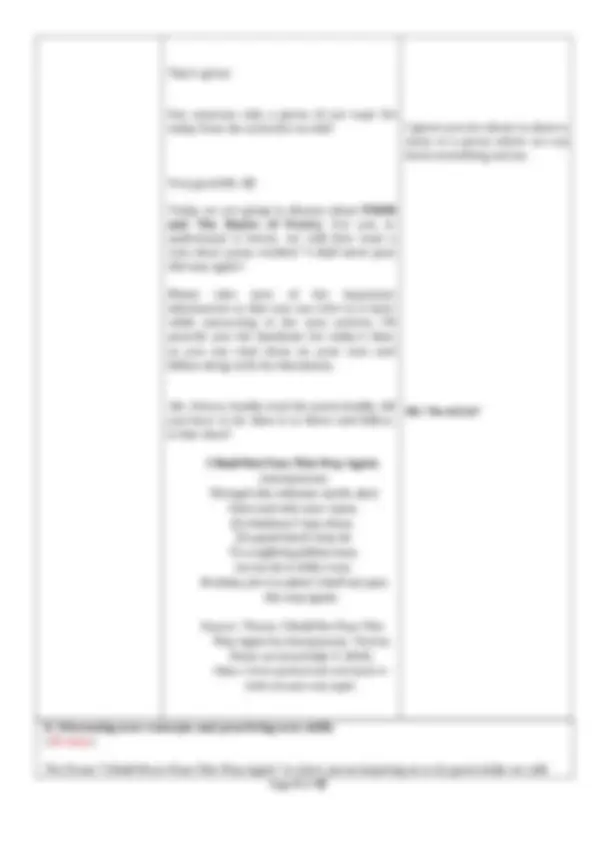
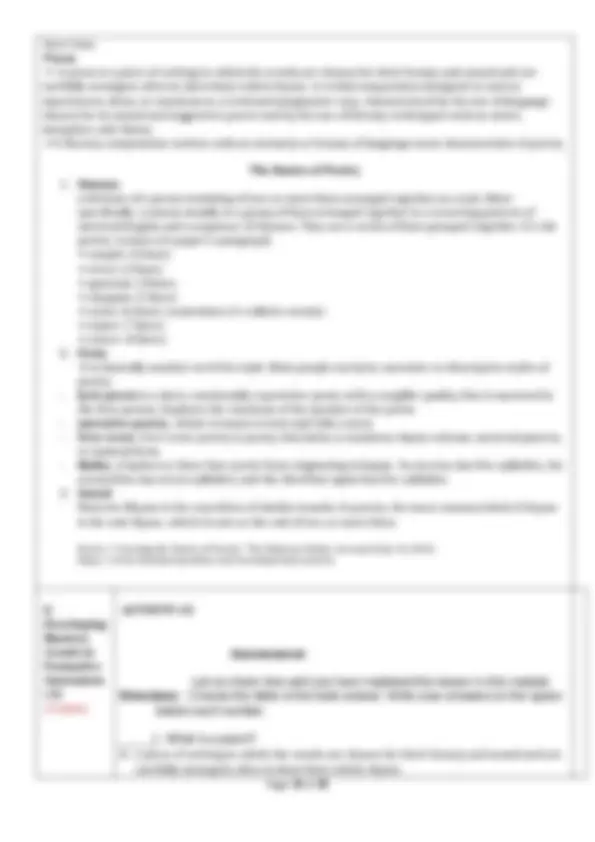
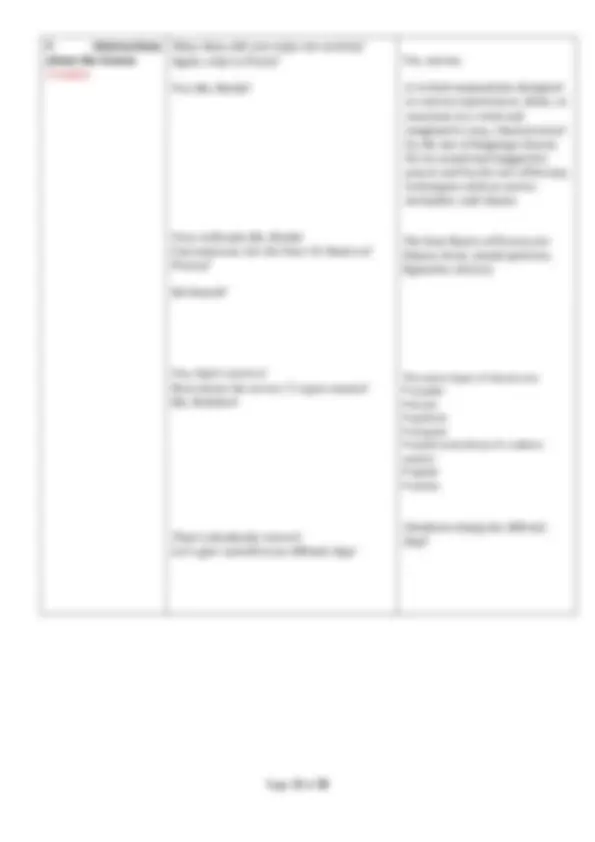
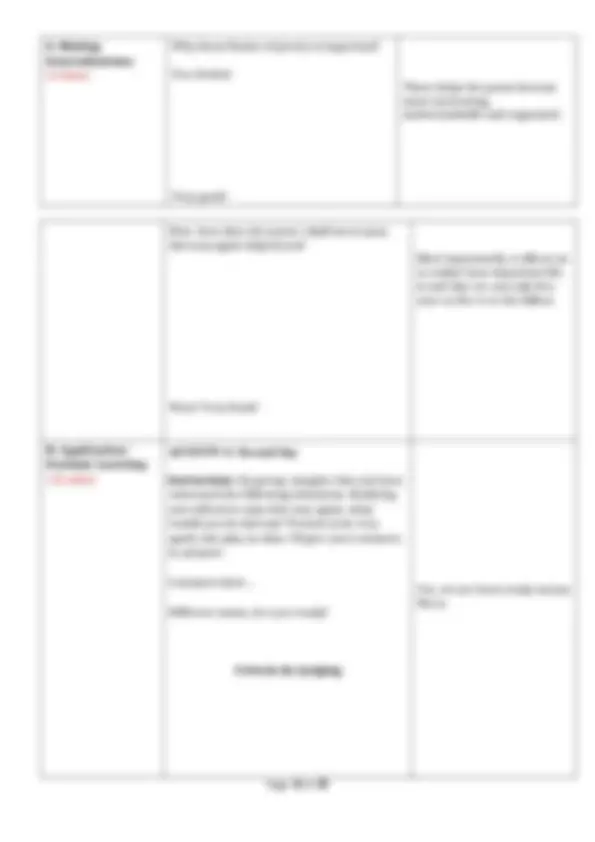
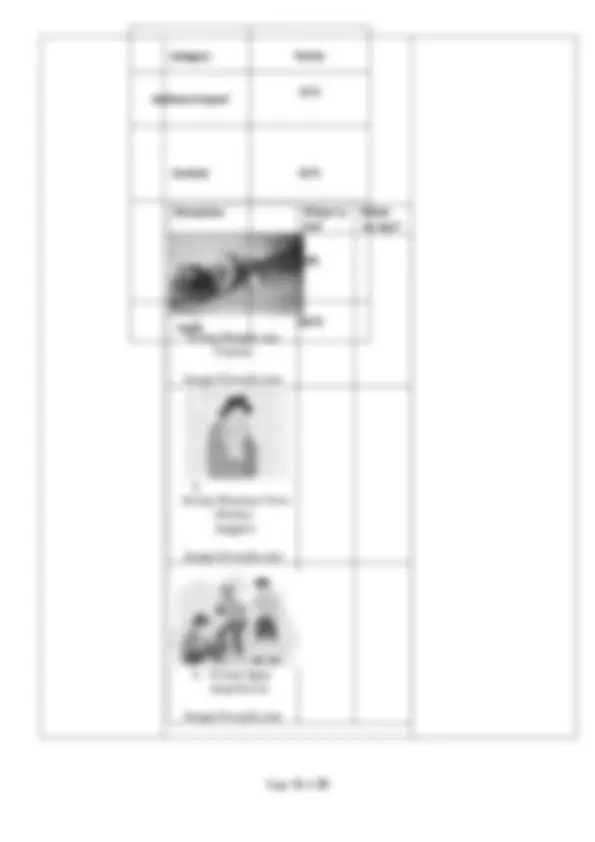



Study with the several resources on Docsity

Earn points by helping other students or get them with a premium plan


Prepare for your exams
Study with the several resources on Docsity

Earn points to download
Earn points by helping other students or get them with a premium plan
Community
Ask the community for help and clear up your study doubts
Discover the best universities in your country according to Docsity users
Free resources
Download our free guides on studying techniques, anxiety management strategies, and thesis advice from Docsity tutors
lesson planning for grade 9 bhvcb
Typology: Summaries
1 / 18

This page cannot be seen from the preview
Don't miss anything!











Republic of the Philippines DEPARTMENT OF EDUCATION Division of Agusan del Sur LAPINIGAN NATIONAL HIGH SCHOOL Lapinigan San Francisco, Agusan del Sur
School LAPINIGAN NATIONAL HIGH SCHOOL Grade Level 9 Teacher NICCA H. TESADO Learning Area ENGLISH Date JANUARY 18, 2023 Quarter II Section SUNKIST Division AGUSAN DEL SUR OBJECTIVES A. Content Standards The learner demonstrates of how and other text types serve as means of enhancing the self, summarizing, assessing; also how to use processing information strategies, understand and identify the Basics of poetry. B. Performance Standards The learner will actively cooperate to share insights and opinions from the poems. C. Learning Competencies/ Objectives At the end of the discussion, the learners are expected to: a. define the poem; b. determine the Basics of Poetry through the poem “I shall never pass this way again”; c. further knowledge about the Basics of poetry and; d. apply their knowledge through completing a statement about the poem. Specific Learning Outcomes D. LC Code I. CONTENT Poem and The Basics of Poetry II. LEARNING RESOURCES A. References file:///D:/Downloads/IDM%20Downloads/English-9-Q2-Mod-2.pdf
III. PROCEDURES Teacher’s Activity Students’ Activity A. Reviewing previous lesson or presenting the new lesson (5 minutes)
Before we start our proper discussion this morning, let’s have first a game called “ Who am I? ”. The class will be divided into three (3) groups. The first group will be “TEAM HUNGRY MY TUMMY”, group 2 is “TEAM MAMA I LOVE CHICKEN NUGGETS”, and group 3 will be “TEAM AGUY MAPRISO KA”. Now, I have here a scoreboard and this scoreboard will help every group to monitor their scores in every activity we will be having this morning. The team with the highest score will be declared as the winner. Team Act 1 Act 2 Act. 3 Act 4 Total score HMT MILCN AMK Instructions: The activity is called “Who am I?!”. I have
different poems here and all you have to do is to guess the identity of the animals or what animals are being described based on the clues given in the poems. I will spin the wheel of names, The moment it stops in the name of your group, you will be the one to read the poem together and answer what animal is being described. . Am I clear, class? Let the game begins, in 3…… 2…… 1…… The winner for this activity is…. The “MOMMY I LOVE CHICKEN NUGGETS! You got one point! Let’s give them an affirm clap! Yes, ma’am. Doing the Affirm2 clap! C. Discussing new concepts and practicing new skills (13 mins.)
“What’s In!” COVID- “One Art,” by Elizabeth Bishop The art of losing isn’t hard to master; so many things seem filled with the intent to be lost that their loss is no disaster . Lose something every day. Accept the fluster of lost door keys, the hour badly spent. The art of losing isn’t hard to master.
CYBERBULLYING TROLL Simon Mack A breath of fresh Spring air on wispy warm skies I sit and contemplate on Cyber’s disguise Where those behind touch screen are brave and so loud And shout with a fork tongue nothing to be proud. Brutality’s intent in words spat with malice Does the person they attack deserve evil’s chalice? Would remarks be so forthright whilst met face to face With those who’s sound honor they online disgrace. Rise above their deeds do not take a bite For attention and backlash is what they’ve in sight Report their cruel actions and move onto others With more positive notions leave trolls to the gutter. I am beyond happy knowing you have enjoyed our first activity! This time, to start with our second activity with the same groupings, I have here pictures with poems of the common problems of the society. I want each group to discuss with your groupmates each issue that I’m going to give you. Write your understanding about the poem in the upper part of the manila paper. On the other half lower part of the manila paper, give at least FIVE important ways on how to prevent these social issues or concerns our society has been facing. RUBRICS IN PRESENTING Category Points Organization 15 % 45 %
Content Presentation 40% Score 100 % Are you all ready? Okay! I will give you 5 minutes to think, gather ideas and discuss with your groupmates. 5 minutes later... Now that you’re done discussing. Group representatives, kindly pick your number for us to know the sequence to who the first to present. Team HUNGRY MY TUMMY, you are the first one to present. To be followed by team “MAMA, I LOVE CHICKEN NUGGETS”. The last one to present is the team “AGUY MAPRISO KA! Are ready group HMY? ALL: YES! WE ARE BORN READY! Yes! We are born ready! You all did a great job! Let us all give ourselves an affirm2 clap. Now that we are done with our first and second activity this morning, what did you feel after the activities? Yes, Ms. Casal? (Doing the affirm2 clap) It was fun and engaging ma’am.
have time. Poem A poem is a piece of writing in which the words are chosen for their beauty and sound and are carefully arranged, often in short lines which rhyme. A verbal composition designed to convey experiences, ideas, or emotions in a vivid and imaginative way, characterized by the use of language chosen for its sound and suggestive power and by the use of literary techniques such as meter, metaphor, and rhyme. A literary composition written with an intensity or beauty of language more characteristic of poetry. The Basics of Poetry
Let us check how well you have mastered the lesson in this module. Directions : Choose the letter of the best answer. Write your answers on the space before each number. _____1. What is a poem? A. a piece of writing in which the words are chosen for their beauty and sound and are carefully arranged, often in short lines which rhyme.
B. Do not convey feelings/emotions of the speaker C. Do not have different types and purpose D. has the same form no matter the type _____2. Which of the following is not a basics of poetry? A. Sound B. Form C. Sonnet D. stanza _____3. What is the speaker’s tone in the poem I Shall Never Pass This Way Again? A. hopeful B. hopeless C. regretful D. humorous _____4. Which message does the speaker wish to convey in the poem, I Shall Never Pass This Way Again? A. The world has a lot of problems. Stay kind. B. Life is short. Let’s spend it doing good. C. People are suffering so be kind. D. We only live once. So be kind. 5-8. Refer to the verse below. “Whereas ye know not what shall be on the morrow. For what is your life? It is even a vapour, that appeareth for a little time, and then vanisheth away. -James 4:14 KJV Bible _____5. To what is our life compared to? A. morrow B. vapour C. time D. vanisheth _____6. What characteristic does it have? A. It only last for a short time. B. It will be useful tomorrow. C. It will last for a long time. D. It comes and goes. _____7. What does it tell us about life? A. Life is good. C. Life is certain B. Life is short. D. Life is uncertain. _____8. What is an optimist likely to be? A. Spend his life trying to leave a legacy. B. Sulk and murmur. C. Spend life in luxury. D. Repay good for good and evil for evil. Interpret the image below by answering the questions that follow.
F. Abstractions about the lesson (5 mins) Okay class, did you enjoy our activity? Again, what is Poem? Yes, Ms. Sheila? Very well said, Ms. Sheila! Can someone cite the four (4) Basics of Poetry? Mr.Daniel? Yes, that’s correct! How about the seven (7) types stanza? Ms. Robelen? That’s absolutely correct! Let’s give ourselves an Affirm2 clap! Yes, ma'am. A verbal composition designed to convey experiences, ideas, or emotions in a vivid and imaginative way, characterized by the use of language chosen for its sound and suggestive power and by the use of literary techniques such as meter, metaphor, and rhyme. The four Basics of Poetry are Stanza, form, sound patterns, figurative devices The seven types of stanzas are couplet tercet quatrain cinquain sestet (sometimes it's called a sexain) septet octave (Students doing the Affirm clap?
G. Making Generalizations (3 mins) Why these Basics of poetry is important? Yes, Ericka? Very good! These helps the poem become more interesting, understandable and organized. Now, how does the poem i shall never pass this way again helped you? Wow! Very Good! Most importantly, it allows us to realize how important life is and that we can only live once so live it to the fullest. H. Application/ Evaluate Learning (16 mins) ACTIVITY 4: Do and Say Instructions : By group, imagine that you have witnessed the following situations. Realizing you will never pass this way again, what would you do and say? Present your very quick role play in class. I’ll give you 5 minutes to prepare. 5 minutes later… Different teams, Are you ready? Criteria for Judging Yes, we are born ready ma’am Nicca.
Congratulations team Aguy Mapriso ka! You are the winner on our fourth activity. Let us all clap our hands for doing a great job today. Clap! Clap! Clap! I. Assignment Before we end, I’ll give you an assignment to be pass tomorrow. ASSIGNMENT: Complete Me Directions: Assess your learning by completing the statements below.
learners who earned 80 % on the formative assessment B. No. of learners who requires additional activities for remediation C. Did the remedial lessons work? No. of learners who have caught up with the lesson. D. No. of learners who continue to require remediation E. Which of my teaching strategies worked well? Why did these work? F. What difficulties did I encounter which my cooperating teacher can help me solve? G. What innovation or localized materials did I use/discove r which I wish to share with